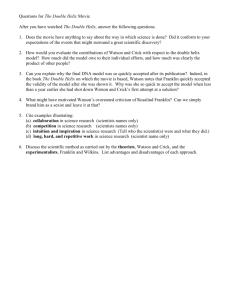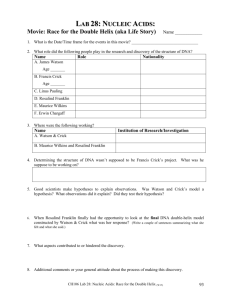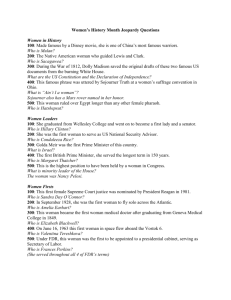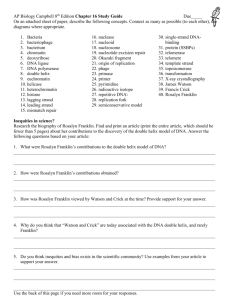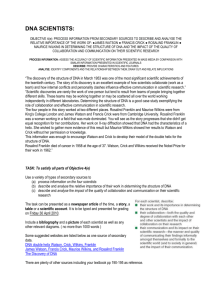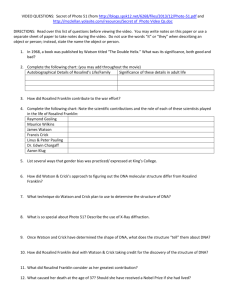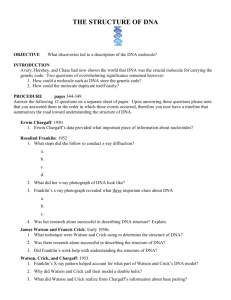article
advertisement
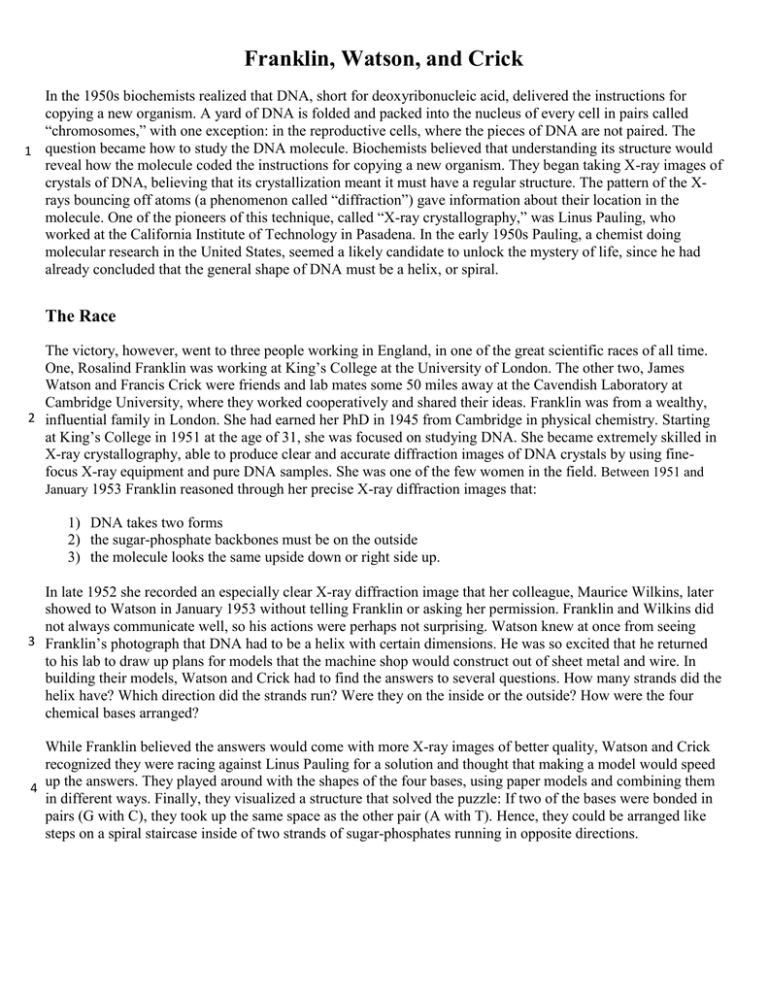
Franklin, Watson, and Crick In the 1950s biochemists realized that DNA, short for deoxyribonucleic acid, delivered the instructions for copying a new organism. A yard of DNA is folded and packed into the nucleus of every cell in pairs called “chromosomes,” with one exception: in the reproductive cells, where the pieces of DNA are not paired. The 1 question became how to study the DNA molecule. Biochemists believed that understanding its structure would reveal how the molecule coded the instructions for copying a new organism. They began taking X-ray images of crystals of DNA, believing that its crystallization meant it must have a regular structure. The pattern of the Xrays bouncing off atoms (a phenomenon called “diffraction”) gave information about their location in the molecule. One of the pioneers of this technique, called “X-ray crystallography,” was Linus Pauling, who worked at the California Institute of Technology in Pasadena. In the early 1950s Pauling, a chemist doing molecular research in the United States, seemed a likely candidate to unlock the mystery of life, since he had already concluded that the general shape of DNA must be a helix, or spiral. The Race The victory, however, went to three people working in England, in one of the great scientific races of all time. One, Rosalind Franklin was working at King’s College at the University of London. The other two, James Watson and Francis Crick were friends and lab mates some 50 miles away at the Cavendish Laboratory at Cambridge University, where they worked cooperatively and shared their ideas. Franklin was from a wealthy, 2 influential family in London. She had earned her PhD in 1945 from Cambridge in physical chemistry. Starting at King’s College in 1951 at the age of 31, she was focused on studying DNA. She became extremely skilled in X-ray crystallography, able to produce clear and accurate diffraction images of DNA crystals by using finefocus X-ray equipment and pure DNA samples. She was one of the few women in the field. Between 1951 and January 1953 Franklin reasoned through her precise X-ray diffraction images that: 1) DNA takes two forms 2) the sugar-phosphate backbones must be on the outside 3) the molecule looks the same upside down or right side up. In late 1952 she recorded an especially clear X-ray diffraction image that her colleague, Maurice Wilkins, later showed to Watson in January 1953 without telling Franklin or asking her permission. Franklin and Wilkins did not always communicate well, so his actions were perhaps not surprising. Watson knew at once from seeing 3 Franklin’s photograph that DNA had to be a helix with certain dimensions. He was so excited that he returned to his lab to draw up plans for models that the machine shop would construct out of sheet metal and wire. In building their models, Watson and Crick had to find the answers to several questions. How many strands did the helix have? Which direction did the strands run? Were they on the inside or the outside? How were the four chemical bases arranged? While Franklin believed the answers would come with more X-ray images of better quality, Watson and Crick recognized they were racing against Linus Pauling for a solution and thought that making a model would speed 4 up the answers. They played around with the shapes of the four bases, using paper models and combining them in different ways. Finally, they visualized a structure that solved the puzzle: If two of the bases were bonded in pairs (G with C), they took up the same space as the other pair (A with T). Hence, they could be arranged like steps on a spiral staircase inside of two strands of sugar-phosphates running in opposite directions. These insights occurred to Crick and Watson between February 4 and February 28, when they announced at lunch in their usual pub that they had found the secret of life. The April 25, 1953 issue of Nature published Crick and Watson’s 900-word article, “A Structure for Deoxyribose Nucleic Acid.” By the 1960s scientists 5 generally embraced the double helix as the structure of DNA, and in 1962 Wilkins, Watson, and Crick received the Nobel Prize in medicine/physiology for their work. Franklin could not share in the prize as it cannot be granted to someone who has passed away. She had died from ovarian cancer at the age of 37 on April 16, 1958, in London. She had a family history of cancer, but her exposure to X-rays may have contributed to her death. And in any case, she may not have had the chance for the award had she been alive. Crick and Watson never told Franklin that they had used her images. It wasn’t until much later that Watson finally admitted in public that he and Crick could not have found the double helix in 1953 without Franklin’s experimental work. If she had survived, would she have been acknowledged and shared in the prize?
